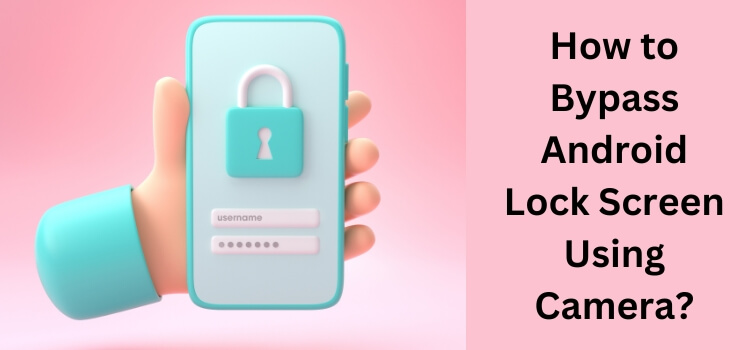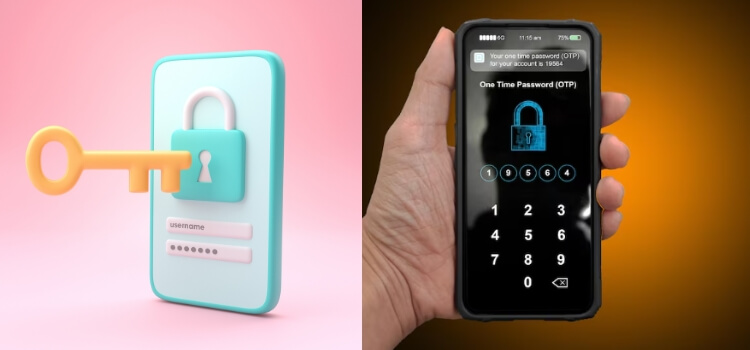As an Amazon Associate, I earn from qualifying purchases
In an increasingly digital world, smartphones have become our lifelines. They store our personal and professional data, keep us connected, and offer countless functionalities. The lock screen, the first barrier to accessing a phone, is crucial for security. But what happens when you forget your password or your device malfunctions? This article delves into an intriguing method—bypassing the Android lock screen using the camera. We’ll explore the feasibility, provide detailed steps, and discuss the ethical implications.

Understanding Android Lock Screens
Types of Lock Screens
Android devices offer several lock screen options to suit different security needs:
- PIN Codes: A simple numeric code, usually 4-6 digits long, offering basic security.
- Patterns: A unique pattern drawn on a 3×3 grid of dots, providing moderate security.
- Passwords: A mix of symbols, digits, and characters that provides increased security.
- Biometric Options: Fingerprint scanning, facial recognition, and iris scanning, which provide convenient and secure access.
Each type has its pros and cons, with biometrics offering the most convenience, but potentially susceptible to spoofing.
Security Features of Android Lock Screens
Modern Android devices are equipped with advanced security features. These include encryption, which protects data at rest, and biometric authentication, which adds an extra layer of security. Regular software upgrades guarantee that security flaws are quickly fixed, preserving the integrity of lock screen protection.
Why Bypass an Android Lock Screen?
Forgotten Passwords or Patterns
It’s common to forget passwords or patterns, especially if they are complex or frequently changed for security purposes. In such cases, knowing how to bypass the lock screen can be crucial to regain access to your device.
Malfunctioning Devices
Hardware or software malfunctions can sometimes prevent you from unlocking your device through the usual methods. For instance, a broken touchscreen or malfunctioning fingerprint sensor can render standard unlocking techniques useless.
Emergency Situations
In emergency situations, such as needing to contact someone urgently or access critical information, bypassing the lock screen may be necessary. This is especially important if the owner is incapacitated or the device is the only means of communication.
Common Methods to Bypass Android Lock Screen
Using Google Find My Device
Google’s Find My Device feature allows users to locate, lock, and erase their Android devices remotely. It can also unlock the device if you have forgotten your password. For this to work, the gadget has to be set up with your Google account and linked to the internet.
Factory Reset
All information on the device, including the lock screen settings, will be deleted with a factory reset. Since this procedure causes total data loss, it should only be used as a last option. Usually, you have to boot into recovery mode and choose the reset option in order to complete a factory reset.
Using Backup PIN
Make sure you have a backup PIN ready, you can use it to unlock your device if you forget your primary lock screen method. This option is often available for pattern and biometric lock screens.

The Camera Trick: Myth or Reality?
Origins of the Camera Bypass Myth
The notion of bypassing an Android lock screen using the camera originated from earlier versions of Android, where certain vulnerabilities allowed access through the camera app. These exploits often involved triggering certain actions within the camera app that inadvertently bypassed the lock screen.
Exploring Feasibility
While the camera trick is largely considered a myth in today’s context, due to numerous security patches and updates, it’s still worth exploring. Some older devices or custom ROMs might still have residual vulnerabilities that can be exploited.
Detailed Guide: Using the Camera to Bypass Lock Screen
Prerequisites and Precautions
Make sure you have these things before you try to use the camera to bypass the lock screen:
- A charged device: Ensure your device has sufficient battery life.
- Internet connection: Some methods might require internet access.
- Backup your data: There’s always a risk of data loss.
Step 1: Accessing the Camera from the Lock Screen
It is possible to access the camera on most Android handsets without unlocking the screen. Open the camera app by swiping left or tapping the symbol.
Step 2: Navigating Through the Camera App
Once the camera app is open, try to access the device settings or notification bar. This step exploits potential vulnerabilities in how the camera app interacts with the lock screen.
Step 3: Exploiting Camera App Vulnerabilities
In earlier Android versions, specific actions within the camera app, such as taking a photo and immediately accessing the gallery, could bypass the lock screen. However, this method is unreliable on newer devices due to security updates.

Alternative Camera-Based Bypass Techniques
Exploiting Face Recognition
Face recognition can sometimes be tricked using a photo or video of the device owner. This method is more relevant to older or less sophisticated face recognition systems.
QR Code Scanning Exploits
Certain QR code scanning apps might allow you to bypass the lock screen by exploiting vulnerabilities in how QR code data is processed. This method is highly specific and not generally applicable.
Potential Risks and Downsides
Security Risks
Your smartphone is vulnerable to security threats like malware or unauthorised access if you try to circumvent the lock screen. Additionally, exploiting vulnerabilities may make your device more susceptible to future attacks.
Data Loss
Methods like factory reset result in complete data loss. Always ensure your data is backed up before attempting any bypass technique. Even non-destructive methods can sometimes result in data corruption or loss.
Legal Implications
Bypassing someone else’s lock screen without permission is unlawful and may result in serious legal penalties. Always use these methods responsibly and ethically. Unauthorized access can result in criminal charges and civil lawsuits.
Securing Your Android Device
Best Practices for Lock Screen Security
- Use a strong password or PIN: Avoid quickly guessable patterns or codes. Combine letters, numbers, and symbols for passwords.
- Enable biometric authentication: Fingerprint or facial recognition adds an extra layer of security.
- Lock automatically: Set your device to lock automatically after a short period of inactivity.
Enabling Two-Factor Authentication
Implementing two-factor authentication (2FA) significantly strengthens security by mandating an additional verification form, such as a code sent to your phone or email. This ensures that even if someone bypasses your lock screen, they cannot access your accounts.
Regular Software Updates
Keeping your device updated ensures you have the latest security patches, protecting against known vulnerabilities. Regular updates from your device manufacturer or carrier help safeguard your device from exploits.
Advanced Techniques for Tech-Savvy Users
ADB Commands
Android Debug Bridge (ADB) commands can be used to unlock your device if USB debugging is enabled.You’ll need a good understanding of the technical aspects and access to a computer in order to use this method. Commands such as adb shell rm /data/system/gesture.key can be used to remove pattern locks.
Custom Recovery
Using a custom recovery tool like TWRP, you can bypass the lock screen by deleting certain system files. This method is for advanced users and carries risks. Flashing custom recovery requires an unlocked bootloader, which may void your warranty.
Third-Party Tools
Software solutions like Dr.Fone and iMyFone LockWiper claim to bypass Android lock screens. These tools can be effective but come with risks, including potential malware and data theft. Always download from reputable sources and read reviews.
Ethical Considerations and Legal Implications
Importance of Ethical Usage
Bypassing a lock screen should be done only on your own device or with explicit permission from the device owner. Unauthorized access is unethical and illegal. Before trying any escape method, it is very important to always make sure you have the right permissions.
Legal Boundaries
It is against the law to get around someone else’s lock screen without their permission, and you could face serious legal implications. Unauthorized access can result in criminal charges and civil lawsuits. Always use these methods responsibly and ethically.
Preventing Unauthorized Access
Encrypting Your Device
Encrypting your device ensures that even if someone bypasses your lock screen, they cannot access your data without the encryption key. Encryption is a strong security measure that keeps your info safe from people who shouldn’t have access to it.
Using Biometric Locks
Biometric locks, which use identification methods like fingerprints or face recognition, provide another, more difficult-to-crack-open layer of protection. These methods are convenient and secure, offering quick access while protecting your device.
Monitoring Device Activity
In order to identify and react to any security risks, it is recommended that you regularly monitor your device for odd activities. Use tools and apps that provide alerts for suspicious activity, ensuring that your device remains secure.
Tools and Software for Bypassing Lock Screens
Popular Software Solutions
Several software solutions claim to bypass Android lock screens, such as Dr.Fone and iMyFone LockWiper. These tools can be effective but come with risks, including potential malware and data theft. Be sure to read reviews and only download software from trusted sources.
Risks of Third-Party Tools
Using third-party tools can expose your device to malware or data theft. Ensure you download tools from reputable sources and read reviews. Always exercise caution when using software that requires extensive permissions or access to sensitive data.
Case Studies
Real-Life Examples of Lock Screen Bypass
To better understand the benefits and drawbacks of different approaches, it is helpful to look at real-life examples of lock screen bypassing.
- Case Study 1: Forgotten Password: A user successfully bypassed their lock screen using Google Find My Device.
- Case Study 2: Malfunctioning Device: A user restored access to their device by performing a factory reset.
- Case Study 3: Emergency Access: A person used a backup PIN to access a locked phone during an emergency.
Lessons Learned
These case studies highlight the importance of having a backup plan and the potential risks involved in bypassing lock screens. They underscore the need for careful consideration and the use of ethical methods when bypassing lock screens.
Frequently Asked Questions
Yes, bypassing someone else’s lock screen without permission is illegal and can have serious legal consequences.
No, the camera trick is largely outdated and ineffective on modern Android devices due to security patches.
Yes, methods like using Google Find My Device or the backup PIN can bypass the lock screen without data loss.
Try using Google Find My Device, the backup PIN, or consult your device manufacturer’s support for assistance.
Use strong passwords, enable biometric authentication, set your device to lock automatically, use 2FA, and keep your software updated.
Conclusion
Bypassing an Android lock screen using the camera is largely a myth in modern devices due to improved security measures. However, understanding the various methods and their implications is crucial for those rare situations where accessing a locked device becomes necessary. Before using any bypass strategies, make sure you’re doing properly and within the law, and put ethics first.
As an Amazon Associate, I earn from qualifying purchases
Leave a Reply